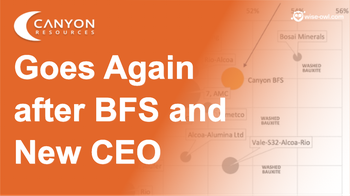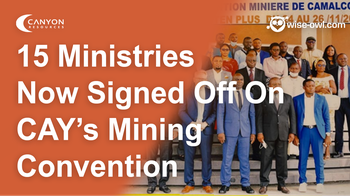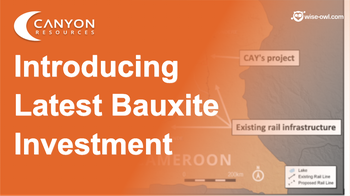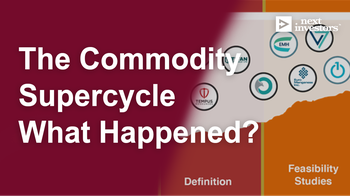CAY’s bauxite project is well advanced with a PFS completed and the BFS currently being delivered. With a JORC resource in place and a maiden ore reserve announced CAY can quickly make a final investment decision after the BFS is completed.
Opened: 14-Feb-2022
Shares Held at Open: 3,000,000
What does CAY do?
Canyon Resources (ASX:CAY) is developing one of the largest undeveloped, high grade direct shipping bauxite deposits globally in Cameroon, Africa.
Bauxite is the primary raw-material used in producing aluminium.
What is the macro theme?
Aluminium is considered a “green metal” due to its infinite recycling capacity & long-lifespan.
It is also considered a critical industrial metal in all manufacturing settings because it is both light-weight and strong. It is also a critical material in the primary technologies that will be the foundation of a low-carbon future including wind power, solar and energy storage (batteries).
More recently, the EU also recognised aluminium as a strategically important material in supporting the transition towards a modernised greener economy.
Why did we invest in CAY?
Advanced development ready project
CAY’s bauxite project is well advanced with a PFS completed and the BFS currently being delivered. With a JORC resource in place and a maiden ore reserve announced CAY can quickly make a final investment decision after the BFS is completed.
One of the largest high-grade Bauxite projects in the world
CAY is developing one of the largest undeveloped, high grade direct shipping ore (DSO) bauxite deposits globally. The project has a JORC Resource of 1 Billion tonnes at 45.2% Alumina with a low silica content (~2%) which makes it ideal for aluminium production.
Solid project economics
Stage 1 development of CAY’s project based on a 5 mtpa DSO operation was modelled in a PFS in 2020 showing a post-tax NPV of US$291m, IRR of 37% with a 4.2 year payback period and CAPEX of US$120m.
DSO style mining methods meaning a fast mining ramp-up stage
Bauxite is a unique commodity in that it is sold as a raw-material with very little processing work done on it. Mining methods are generally very simple, with the Bauxite being dug up, stock-piled and shipped directly to purchasers without any processing. As a result production rates can be ramped up very quickly.
What do we expect CAY to deliver?
Objective #1: Mining convention converted into a mining permit.
Objective #2: Bankable Feasibility Study (BFS)
We want to see the BFS completed and a move into the final investment decision/project financing stage. We are hoping to see this completed in the first half of 2022.
Objective #3: Bankable Feasibility Study (BFS)
We want to see the BFS completed and a move into the final investment decision/project financing stage. We are hoping to see this completed in the first half of 2022.
Objective #4: Final Investment Decision and financing
In order to get the mine operational, CAY needs to make a final investment decision along with some progress on financing the project.
Objective #5: Strengthening of the in-country team to aid project into development
We want to see CAY strengthen its in-country team so that there is project delivery experience from financing all the way down to operations.
What could go wrong?
Permitting risk
There is a risk the mining convention negotiations fall through and CAY are not granted the mining permits. Given there are a lot of specifics related to the permitting process, we believe this is the single biggest risk for CAY at the moment.
Development risk
The challenge with Bauxite mines that sit in-land like CAY’s is that they need to have well-built out infrastructure for the projects to be considered economically viable. Cameroon has recently made some upgrades to it’s rail infrastructure but to support a project like CAY’s will need to make more investment. There is a risk this never materialises and the project is deemed stranded.
Commodity pricing
Bauxite prices are historically un-correlated with the price of aluminium, with demand for aluminium increasing there is a risk that bauxite prices lag or fail to respond to increased demand higher up in the supply-chain.
Technology risk
Aluminium is recyclable and with an increased focus on improving recycling technologies, there is a risk that demand for new aluminium is met by recycling and therefore demand for new bauxite ore is diminished.
Geographic risk
While we believe Cameroon’s current political climate is stable, there have been four coups in the last 4 years in the West Africa region. CAY’s project is subject to the volatility of doing business in this part of the world. Geopolitical risks form a significant part of CAY’s overall risk profile.
Funding risk
CAY’s project is located in Cameroon which is still a developing mining jurisdiction, there is a risk that the company fails to attract development financing with investors thinking the geopolitical risk is too high. In addition in the short term, CAY is reliant on tapping the market for funds as it moves toward bigger financing rounds.
What is our investment plan?
At Wise-Owl we invest in later stage companies with a view to hold for 4 to 7 years.
Our plan is to hold a position in CAY to see it into production.
As with all our new investments, we have a 90 day trading blackout. After 90 days we are allowed to sell a maximum of 20% of our total position.
We may look to sell ~20% of our position late in 2022 if the share price re-rates as the objectives we want to see are achieved.
Disclosure: The authors of this article and owners of Wise-Owl, S3 Consortium Pty Ltd, and associated entities, own 3,000,000 CAY shares at the time of writing this memo. S3 Consortium Pty Ltd has been engaged by CAY to share our commentary on the progress of our investment in CAY over time.
CAY Goes Again after BFS, New CEO and a Surging Bauxite Price
Jul 13, 2022
Jul 13, 2022 |
15 min
Our Investment Canyon Resources (ASX:CAY) released a Bankable Feasibility Study (BFS) for its 100% owned bauxite project in Cameroon, Africa. Today we breakdown the study, recent share price movements, and specific risks to our Investment.

15 Ministries now signed off on CAY’s Mining Convention - Final Sign off by Government Next
Feb 28, 2022
Feb 28, 2022 |
11 min
Canyon Resources (ASX: CAY), the 100% owner of one of the largest undeveloped, high grade direct shipping Bauxite deposit in Cameroon, has just announced that all of the key terms on its "Mining Convention" have been agreed to.

Introducing our Latest Investment: ASX:CAY
Feb 14, 2022
Feb 14, 2022 |
30 min
Introducing our latest Investment Canyon Resources (ASX:CAY). CAY is developing one of the world's largest, high grade direct shipping bauxite deposits globally.

Strategic investor tips in $12.1M - 42% premium to share price
Dec 21, 2022
Dec 21, 2022 |
1 min
Certificate Of Environmental compliance granted
Oct 25, 2022
Oct 25, 2022 |
58.6 seconds
Targeting prospects outside of 1BN tonne resource area
Oct 10, 2022
Oct 10, 2022 |
54.6 seconds
Government expresses support of 1BN tonne bauxite project
Oct 10, 2022
Oct 10, 2022 |
1 min
CAY enters trading halt
Feb 24, 2022
Feb 24, 2022 |
57.0 seconds
Tax loss selling over, market back in August?
Jul 2, 2022
Jul 2, 2022 |
19 min
Tax loss selling over, catalysts in, market back in August? A selection of 10 of the most beaten up stocks in our Portfolio in the last six months

Mainstream Media Catching on to the Commodities Supercycle
Mar 5, 2022
Mar 5, 2022 |
26 min
It looks like the commodities supercycle we have been predicting is now underway. We’ve been saying it's coming for a long time but are now seeing firm evidence that it's here across further recent commodity price spikes and mainstream media reports.

The War Begins, Cybersecurity, Food Security, Energy Independence and Precious Metals
Feb 26, 2022
Feb 26, 2022 |
17 min
The Russian troop build-up had been happening for the last couple of months and we think the market had slowly been pricing in a potential conflict, especially one that could accelerate the “west versus east” tensions and all the ramifications that come with it.

Why we invest in Oil & Gas and Precious Metals
Feb 21, 2022
Feb 21, 2022 |
17 min
Across our portfolios we have investments in battery metals, oil & gas, precious metals, medicinal cannabis, early stage tech, green energy, growth stocks and new energy materials.
